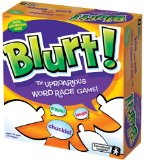Welcome to Purple Pawn, covering games played around the world by billions of people every day.
 Here’s a brief lowdown on Blurt! before the rest of the review. I brought Blurt! to Thanksgiving dinner with my family. We played Blurt! for 15 minutes, 14 minutes of which we complained about not wanting to play Blurt! anymore.
Here’s a brief lowdown on Blurt! before the rest of the review. I brought Blurt! to Thanksgiving dinner with my family. We played Blurt! for 15 minutes, 14 minutes of which we complained about not wanting to play Blurt! anymore.
Yeah…
The idea behind the game seemed really great. Cards that have definitions on them, and you have to call out the right word to advance your piece. Unfortunately, it’s not pulled off very well.
One player, the reader, rolls the die. Whatever number comes up, you read the definition off a card that corresponds with that number. Who ever calls out the right word first moves the number of spaces rolled on the die. Then the role of the reader passes to the next player. There’s also rules for people who land on the same space as someone else.
Very simple.
The main problem with Blurt is that all the definitions are VERY easy for your average adult. Even the “hard” side of the card wasn’t very hard. There didn’t seem to be any level of difficulty change for higher numbers rolled vs lower numbers rolled. Our game came down to whoever screamed the right word out the loudest would move.
Some people at the table ended up getting a lot of words right, but on rolls of 1 or 2, while other people (at no real increase in difficulty) where moving 5 or 6 spaces at a time.
The game might be better suited to tweens, whose vocabulary may not be up to snuff of that of an adult, but we didn’t run across anything really taxing for even that age range.
Blurt! has potential. With some harder cards, and maybe an extra mechanic or two, it could really be a good party game. As it stands right now, there’s a LOT of better party games out there to spend your money on.
A copy of Blurt! was provided for free to review by Educational Insights.
No Comments
Sorry, the comment form is closed at this time.
Trending
- Massdrop.com
- Oh the Irony—Illuminati Card Game Continues to Inspire Conspiracy Theorists
- Footprints, an Educational Ecology Game
- USPS Adds Board Game Flat Rate Box
- Home
- Baila, the Estonian Drinking Card Game
- Crystal Caste Wins Dice Patent Suit Against Hasbro
- Mirror Game, Red and Blue
- Hasbro and Mattel Merger?
- Are Board Games Dangerous?
Archives
Most Popular Articles
- Oh the Irony—Illuminati Card Game Continues to Inspire Conspiracy Theorists
- The 20 Most Valuable Vintage Board Games
- The Truth About Dominoes On Sunday in Alabama
- Sequence Game, and Variants
- USPS Adds Board Game Flat Rate Box
- Baila, the Estonian Drinking Card Game
- The 13 Most Popular Dice Games
- Are Board Games Dangerous?
- Guess Who? The Naked Version
- What Happened to the Jewel Royale Chess Set?
Recent Posts
- Toy Fair 2019—Breaking Games
- Talisman Kingdom Hearts Edition
- Toy Fair 2019—Winning Moves
- Toy Fair 2019—Games Workshop
- Toy Fair 2019—Star Wars Lightsaber Academy
- Toy Fair 2019—Stranger Things Games
- Toy Fair 2019—HABA
- Licensing Roundup
- Game Bandit
- 2018 A Difficult Year For Hasbro But Not For D&D Or MtG
Recent Comments
- on Toy Fair 2019—Winning Moves
- on Game Bandit
- on Second Look—Dungeons & Dragons Waterdeep Dragon Heist
- on Crowdfunding Highlights
- on Beyblade SlingShock
- on Game Bandit
- on Game Bandit
- on Watch This Game!, the Board Game Review Board Game
- on Second Look—Vampire: The Masquerade 5th Edition
- on Palladium Books Loses Robotech IP License, Cancels Five-Year-Overdue Robotech RPG Tactics Kickstarter




